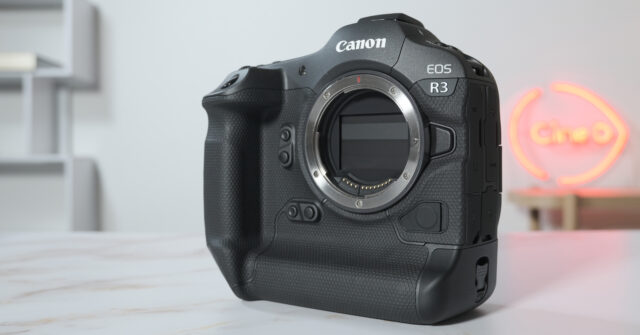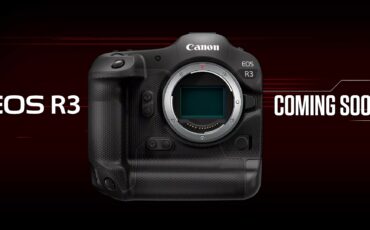Canon EOS R3 Launched with 6K 60P Internal RAW Video Recording and Very Long Recording Time
Music Courtesy of Epidemic Sound
The wait is over! Canon has officially launched the Canon EOS R3, with impressive photo and video capabilities: 30fps burst mode with AE/AF tracking, Dual Pixel CMOS AF II, a new Eye control AF that focuses where you look at (In photo mode only), 6K 60P internal RAW video recording, 4K 120P, Canon LOG 3, and so much more. So let’s take a closer look at the EOS R3, which is one of the most impressive mirrorless camera we might see this year!
The development of the Canon EOS R3 was announced back in April 2021, and the camera was used by some photographers during the Tokyo Olympic games this summer. This camera is mainly designed for professional sports, wildlife, and news photographers, but it also packs a ton of features for filmmakers.
In many ways, the EOS R3 is seen as a mirrorless version of the top-of-the-line EOS-1D series DSLRs. According to the company, this new camera sports over “100 improvements upon Canon’s mirrorless and DSLR models.”
New sensor of the Canon EOS R3
At the core of the Canon EOS R3 is a brand new 24.1-megapixel backside-illuminated stacked CMOS sensor. This sensor is supposed to almost eliminate rolling shutter distortion, at least in photo mode. Remember, this camera is mainly designed for people shooting sports and fast pacing actions, so having low rolling shutter distortion will help.
Canon R5 C Ultimate Video Manual
There’s no word yet on how this new sensor will perform in low-light situations, except that it can focus in very harsh lighting conditions as low as -7.5 EV.

Photo capabilities
On the photography side, the Canon EOS R3 can shoot in burst mode at up to 30 frames per second using the electronic shutter with AE and AF tracking, even when shooting RAW files. But, of course, you better have high-speed memory cards to handle such a massive amount of data.
Talking about storage, the Canon EOS R3 features dual card slots, including a UHS-II SD card slot and a CFexpress card slot. Among the supported features are separate still photo recording, separate still photo/movie recording, and simultaneous movie recording to two cards.
For photographers, you can shoot with a shutter speed ranging from 30 seconds to 1/64000th of a second. The electronic shutter can also be used with both Canon and third-party flashes for the first time.
Canon also introduced Flicker detection and a High-Frequency anti-flicker shooting mode to detect and correct flickering light sources and prevent banding or color and exposure issues.
Video recording
Let’s talk about our specialty at CineD: video features. Let’s say that you won’t be disappointed by the Canon EOS R3 here. Indeed, the camera can record footage in up to 6K 60P internally in CRM RAW or CRM RAW Light formats.

Also, the EOS R3 can record in 4K 120p but in MP4 this time. Johnnie my colleague ran a brief test (See the above video) and the good news is, that the new camera does not overheat easily! He simply got tired after waiting for over two and a half hours for the camera to get warm…Eventually, the 1TB CFexpress card got full. (6K/25p, RAW Lite settings).
Officially, Canon states that the EOS R3 can record these times depending on the mode:
- 4K 60p (6K oversampled): 60mins or more
- 4K 120p: 12mins

All projects don’t need to be shot in full 6K 60P RAW but don’t worry; you can record CRM light or MP4 footage in various All-I, IPB, or IPB Light flavors. Again, it gives you a choice to select the bit rate that better suits the project you’re shooting.

The Canon EOS R3 includes the famous Canon LOG 3 picture profile, enabling 10-bit internal recording and 10bit HDR PQ.

Also, you can record to both memory cards (SD and CFExpress) simultaneously in MP4, so you have a copy of your footage if one memory card fails.

IBIS
Like the Canon EOS R5/R6, the Canon EOS R3 features a 5-axis In-Body Image Stabilizer. Still, you can combine the IBIS with the optical Image Stabilizer in selected RF lenses for up to 8-stops of image stabilization.
Multi-Function Shoe
A new addition to the EOS R3 is Canon’s new Multi-Function Shoe. This new “hot shoe” enables direct communication between the camera and accessories without any cables.
In August, we reported about the TASCAM CA-XLR2d audio XLR microphone adapter, which was the first accessory launched to use this new standard. The CA-XLR2d gives you two-channel recording with professional XLR microphones inputs.

Along with the EOS R3, Canon also launched a second Multi-Function Shoe accessory: the DM-E1D. This directional stereo microphone is powered by the camera itself and uses digital audio processing.
Canon EOS R3 Autofocus
You got it, the EOS R3 can take high-speed photos and videos, but none of that is any good if the images are blurry. On the autofocus side, the EOS R3 is powered by Dual Pixel CMOS AF II technology, like the EOS R5/R6. However, the R3 can focus in 0.03 seconds; it is the fastest EOS R series camera yet.
According to Canon, “the EOS R3 features an improved Deep Learning algorithm.” In short, it means that the AF tracking can follow human and animal eye, body, and face detection as well as head detection for humans in both stills and videos. In addition, eye, face, head, and body detection are now available in all AF modes, as well as a new Flexible Zone allowing users to select the size and shape of the Zone AF area.
With motorsports photographers in mind, a new vehicle tracking function is now also available. This function allows you to track motorbikes, open cockpit Formula cars, and GT/rally cars – with the ability to prioritize the vehicle or the driver’s helmet.
Eye Control AF
You have various ways to control all these AF options on the EOS R3. The two “standard” ones are the quick smart controller and the precise multi-controller. These controllers are similar to the ones found on the EOS-1DX Mark III.
However, Canon introduced a new way to control where you want to focus, and there are no buttons/dials for it: this is your eye. This new mode is called Eye Control AF.
Indeed, this mode only works when you’re looking inside the viewfinder.

According to Canon, “this intuitive and pioneering AF point selection method moves the focus point to where the photographer looks. In situations where the story can quickly unfold, this allows photographers to instinctively focus on the action with just a look.”
This is the first time I have seen this feature inside a camera, and I can’t wait to see/experience how it works. However, this mode is unfortunately only available in photo mode. Video filmmakers have to make do with more conventional methods of (auto-)focusing.
Connectivity
The EOS R3 features numerous wireless connectivity options, including built-in Bluetooth 5.0 and 5GHz Wi-Fi. It’ll be easy to connect your camera to your smartphone or Wi-Fi network. Photographers can transmit images to clients via FTP. For existing EOS R5 and EOS-1D X Mark III users, the network settings can be shared between the three cameras.
The camera also features a built-in Gigabit Ethernet port if you work in a crowded area and need a high-speed wired connection.

For filmmakers, the camera’s left side also features a 3.5mm headphone output, a 3.5mm mini-jack input, a USB Type-C port, and a micro-HDMI port. However, I don’t get why Canon went with a micro-HDMI connector – which is the worst video output port ever; it is 99% of the time flimsy and not reliable – instead of a full-size one.
A new smartphone holder accessory for the EOS R3, the Smartphone Link AD-P1, allows users to mount their iOS or Android device on top of the Multi-Function Shoe Adapter and easily transmit images via the new MFT app. In addition, the Canon Camera Connect app now enables the EOS R3 firmware to be updated via your phone – a first for an EOS camera.
Canon EOS R3 camera body
The body of the Canon EOS R3 is made out of a new lightweight, dust, and water-resistant magnesium. No surprise here that this camera will be built like a tank to support the harshest conditions on earth. The camera body features weather resistance, which can be maintained when using existing Speedlites by connecting them to the newly announced Multi-Function Shoe Adapter AD-E1.

At the back of the camera, you’ll find a blackout-free 5.76 million dot electronic viewfinder with a low lag and refresh rate of up to 120 fps at full resolution. There is also a new high-resolution Vari-Angle 4.1-million dot touch screen. This flip-out screen is a much-welcomed addition compared to the EOS-1D X Mark II/III. Talking about it, the Canon EOS R3 uses the same LP-E19 battery pack as the 1D X Mark II/III.
Price and availability
The Canon EOS R3 will be available for $5,999 and is scheduled to ship in November 2021.
For more information, please visit Canon’s website here.
What do you think about the Canon EOS R3? Do you consider upgrading to it over the R5/R6? What feature are you the most excited about? Don’t hesitate to let us know in the comments down below!


































